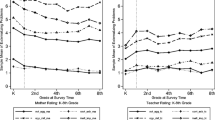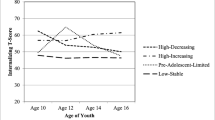Abstract
Evidence of the continuity of early problem behaviors in young girls and boys was examined developmentally. Data were gathered on 104 mother-child dyads from low-income families when children were between 1 and 5 years of age. Difficult temperament, aggression, and noncompliance from 12 to 24 months, and externalizing and internalizing problems at 36 and 60 months, were assessed. The results provide evidence for the continuity of early behavioral and emotional problems and support for the early differentiation between internalizing and externalizing problems. Implications of the current findings for prevention efforts are presented.
Similar content being viewed by others
REFERENCES
Achenbach, T. M., Edelbrock, C., & Howell, C. (1987). Empirically-based assessment of the behavioral/emotional problems of 2–3 year old children. Journal of Abnormal Child Psychology, 15, 629–650.
Ainsworth, M. D. S., & Wittig, B. A. (1969). Determinants of Infant Behavior (Vol. 4). London, England: Metheun.
American Psychiatric Association. (1980). Diagnostic and statistical manual of mental disorders (3rd ed.). Washington, DC: Author.
American Psychiatric Association (1987). Diagnostic and statistical manual of mental disorders (3rd ed., rev.). Washington, DC: Author.
Applegate, B., Lahey, B. B., Hart, E. L., Biederman, J., Hynd, G. W., Barkley, R. A., Ollendick, T., Frick, P. J., Greenhill, L., McBurnett, K., Newcorn, J. H., Kerdyk, L., Garfinkel, B., Waldman, I., & Shaffer, D. (1997). Validity of the age-of-onset criterion for ADHD: A report from the DSM-IV field trials. Journal of the American Academy of Child and Adolescent Psychiatry, 36, 1211–1221.
Bates, J. E., Freeland, C. A., & Lounsbury, M. L. (1979). The infant characteristics questionnaire. Child Development, 48, 195–203.
Bird, H. R., Gould, M. S., & Staghezza, B. (1993). Patterns of diagnostic comorbidity in a community sample of children aged 9 through 16 years. Journal of the American Academy of Child and Adolescent Psychiatry, 32, 361–368.
Campbell, S. B. (1994). Behavior problems in preschool children: A review of recent research. Journal of Child Psychology and Psychiatry, 36, 113–149.
Campbell, S. B., & Ewing, L. J. (1990). Follow-up of hard-to-manage preschoolers: Adjustment at age 9 and predictors of continuing symptoms. Journal of Child Psychology and Psychiatry, 31, 871–889.
Campbell, S. B., Ewing, L. J., Breaux, A. & Szumowski, E. K. (1986). Parent-referred problem three-year-olds: Follow-up at school entry. Journal of Child Psychology and Psychiatry, 27, 473–488.
Campbell, S. B., Szumowski, E. K., Ewing, L. J., Gluck, D. S., & Breaux, A. M. (1982). A multidimensional assessment of parent-identified behavior problem toddlers. Journal of Abnormal Child Psychology, 10, 569–592.
Caspi, A., Henry, B., McGee, R., Moffitt, T, & Silva, P. (1995). Temperamental origins of child and adolescent behavior problems: From ages three to fifteen. Child Development, 66, 55–68.
Crockenberg, S., & Litman, C. (1990). Autonomy as competence in 2-year-olds: Maternal correlates of child defiance, compliance and self-assertion. Developmental Psychology, 961–971.
Cummings, E. M., Iannotti, R. J., & Zahn-Waxler, C. (1989). Aggression between peers in early childhood: Inidividual continuity and developmental change. Child Development, 60, 887–895.
Earls, F., & Jung, K. G. (1987). Temperament and home environment characteristics as causal factors in the early development of childhood psychopathology. Journal of the American Academy of Child and Adolescent Psychiatry, 26, 491–498.
Fischer, M., Rolf, J. E., Hasazi, J. E., & Cummings, L. (1984). Follow-up of a preschool epidemiological sample; Cross-age continuities and predictions of later adjustment with internalizing and externalizing dimensions of behavior. Child Development, 55, 137–150.
Garcia Coll, C., Kagan, J., & Reznick, J. S. (1984). Behavioral inhibition in young children. Child Development, 55, 1005–1019.
Kazdin, A. E. (1995). Treatment of antisocial behavior in children: Current status and future directions. Psychological Bulletin, 102, 187–203.
Keenan, K., & Shaw, D. (1994). The development of aggression in toddlers: A study of low-income families. Journal of Abnormal Child Psychology, 22, 53–77.
Keenan, K., & Shaw, D. (1997). Developmental and social influences on young girls' early problem behavior Psychological Bulletin, 121, 97–113.
Keenan, K., Shaw, D., Walsh, B., Giovanelli, J., & Delliquadri, E. (1997). Rates of DSM-III-R disorders in preschoolers. Journal of the American Academy of Child and Adolescent Psychiatry, 36, 620–627
Lee, C. L., & Bates, J. E. (1985). Mother-child interaction at age two and perceived difficult temperament. Child Development, 56, 1314–1325.
Loeber, R. (1982). The stability of antisocial and delinquent child behavior: A review. Child Development, 53, 1431–1446.
Martin, J. (1981). A longitudinal study of the consequence of early mother-infant interaction: A microanalytic approach. Monographs for the Society for Research in Child Development, 46 (3, Serial No. 190).
Matas, L., Arend, R., & Sroufe, L. A., (1978). Continuity of adaption in the second year: The relationship between attachment and later competence. Child Development, 49, 547–556.
Maziade, M., Cote, R., Bernier, H., Boutin, P., & Thivierge, J. (1989a). Significance of extreme temperament in infancy for clinical status in pre-school years I: Value of extreme temperament at 4–8 months for predicting diagnosis at 4.7 years. British Journal of Psychiatry, 154, 535–543.
Maziade, M., Cote, R., Bernier, H., Boutin, P., & Thivierge, J. (1989b). Significance of extreme temperament in infancy for clinical status in pre-school years II: Patterns of temperament change and implications for the appearance of disorders. British Journal of Psychiatry, 154, 544–551.
Olweus, D. (1979). Stability of aggressive patterns in males: A review. Psychological Bulletin, 86, 852–875.
Orvaschel, H., & Puig-Antich, J. (1987). Schedule for Affective Disorders and Schizophrenia for School-Age Children — Epidemiologic 4th Version. Ft. Lauderdale, FL: Nova University, Center for Psychological Study.
Pianta, R. C., & Caldwell, C. B. (1990). Stability of externalizing symptoms from kindergarten to first grade and factors related to instability. Development and Psychopathology, 2, 247–258.
Pianta, R. C., & Castaldi, J. (1989). Stability of internalizing symptoms from kindergarten to first grade and factors related to instability. Development and Psychopathology, 1, 305–316.
Prior, M., Smart, D., Sanson, A., & Oberklaid, F. (1993). Sex differences in psychological adjustment from infancy to 8 years. Journal of the American Academy of Child and Adolescent Psychiatry, 32, 291–304.
Richman, N., Stevenson, J., & Graham, P. (1985). Sex differences in outcome of pre-school behaviour problems. In A. R. Nicol (Ed.), Longitudinal studies in child psychology and psychiatry (pp. 75–89). New York: John Wiley & Sons.
Robins, L. N., West, P. A., & Herjanic, B. L. (1975). Arrests and delinquency in two generations: A study of black urban families and their children. Journal of Child Psychology and Psychiatry, 16, 125–140.
Rose, S. L., Rose, S. A., & Feldman, J. F. (1989). Stability of problem behavior in very young children. Development and Psychopathology, 1, 5–19.
Shaw, D. S., & Bell, R. Q. (1993). Developmental theories of parental contributors to antisocial behavior. Journal of Abnormal Child Psychology, 21, 493–518.
Author information
Authors and Affiliations
Rights and permissions
About this article
Cite this article
Keenan, K., Shaw, D., Delliquadri, E. et al. Evidence for the Continuity of Early Problem Behaviors: Application of a Developmental Model. J Abnorm Child Psychol 26, 441–452 (1998). https://doi.org/10.1023/A:1022647717926
Issue Date:
DOI: https://doi.org/10.1023/A:1022647717926




